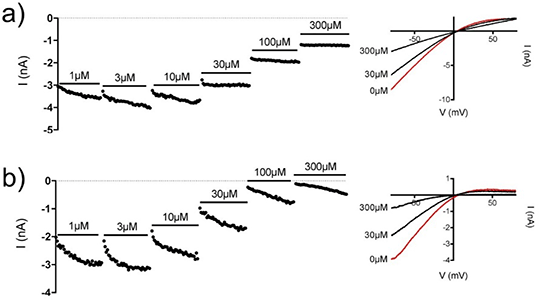| 089P London, UK Pharmacology 2016 |
Effect of antiarrhythmic drugs on small conductance calcium-activated potassium channel
Introduction: Atrial fibrillation (AF) is the most common type of arrhythmia (1). Current pharmacological treatment for AF is moderately effective and/or increases the risk of serious ventricular adverse effects (2). To avoid ventricular adverse effects, a new target has been considered, the small conductance calcium-activated K+ channels (KCa2.x, SK channels). In the heart KCa2.x channels are predominantly expressed in atria compared to ventricles, and pharmacological inhibition of the channel confers atrial selective prolongation of the cardiac action potential and converts AF to sinus rhythm in animal models of AF (3). Whether antiarrhythmic drugs (AAD) recommended for treating AF target KCa2.x channels is unknown. To this end, we tested a large number of AAD on the human KCa2.2 and KCa2.3 channels to assess their effect on this new target.
Method: Whole-cell experiments on HEK cell lines expressing hKCa2.2 and hKCa2.3 channels were conducted using the automated patch-clamp platform QPatch 16 (Sophion, Denmark). Currents were recorded in symmetrical K+ using a 2 s voltage ramp from -80 mV to +80 mV. The effects of dronedarone, amiodarone, flecainide, disopyramide, sotalol, ibutilide, quinidine, propafenone, vernakalant and dofetilide were tested in increasing concentrations.
Results: Only dofetilide and propafenone inhibited the human KCa2.2 and KCa2.3 currents, with no subtype selectivity (see Table 1).
Table 1 IC50 values of dofetilide and propafenone (mean +/- SEM).
| hKCa2.2 | hKCa2.3 | |
| Dofetilide | 60 ± 10 µM L-1 (n = 13) | 90 ± 10 µM L-1 (n = 13) |
| Propafenone | 80 ± 20 µM L-1 (n = 6) | 42 ± 4 µM L-1 (n = 8) |

Figure 1. Representative current-time plots of a) dofetilide and b) propafenone inhibition on the hKCa2.3 (left) and their current-voltage recordings (right).
Conclusions: Of the AAD recommended for treatment of AF only dofetilide and propafenone inhibited hKCa2.x channels, with no subtype selectivity. Whether this inhibition has clinical importance for their antiarrhythmic effects is unlikely as the calculated IC50 are very high compared to the effective free therapeutic plasma concentration of the drugs (4) .
References: 1. Nattel S (2002). Nature 415: 219-226. 2. Waks JW and Zimetbaum P (2016). J Cardiovasc Pharmacol Ther Published online before print. 3. Diness JG et al. (2015) J Cardiovasc Pharmacol 66: 441-448. 4 Redern et al. (2003) Cardiovasc. Res. 58: 32-45.

